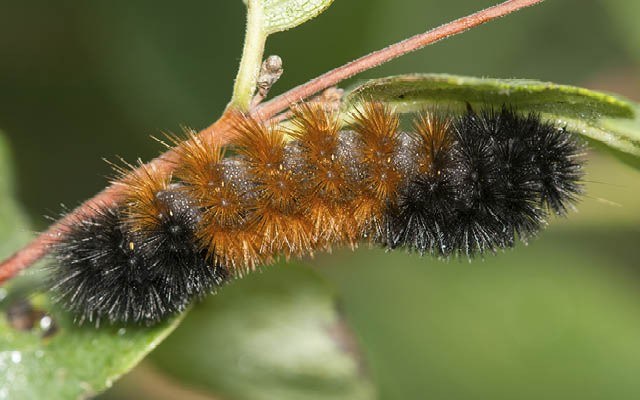Walking or biking along the Valley Trail recently you may have noticed an abundance of black and orange caterpillars making their way across the path. Ever wonder where they are headed? These fascinating little critters, known as the Woolly Bear Caterpillars (Pyrrharctia isabella) make their annual appearance each fall in Whistler, joining many other creatures as they hurry to prepare for the quickly approaching winter months.
The Woolly Bear Caterpillar is the larva of the Isabella Tiger Moth. Predominantly found in cold regions, the Woolly Bear larva emerges from its egg in the early fall and begins its journey to find the ideal location where it can overwinter.
Crawling at a rate of 0.08 kilometres per hour, the Woolly Bear travels nearly two kilometres across the roads and paths of Whistler each and every day in search of a protected area to hunker down for the winter. Believe it or not, the speed in which they travel is actually fast in the caterpillar world!
This vulnerable mode of transportation makes them extremely susceptible to predation, including by the tires of passing-by bikes. Under bark or within the cavities of rocks, these mature caterpillars literally freeze solid until reemerging in the spring. Measuring an average of 2.5-3.8 centimetres, the Woolly Bear Caterpillars are covered in short, stiff bristles of hair, dawning black stripes at its head and rear, and a reddish brown stripe around its middle.
When disturbed or touched, they utilize their main defense mechanism and curl up into a tiny ball.
These vegetarians are known to eat a variety of weeds, grasses, clover, herbs and dandelions.
According to legend, the Woolly Bear Caterpillar carries with it an indication of the severity of the upcoming winter. It is believed that if the reddish brown stripe around its middle is thick, the upcoming winter weather will be mild. Conversely, a narrow middle stripe is said to predict a harsh winter.
While some scientists agree with this prediction, many describe the finding as merely legend as there is great variety in colour distribution among these caterpillars, for particular reasons such as food availability, temperature or age.
As the warm weather prevails and the world reawakens, the Woolly Bear emerges and begins to spin a fuzzy cocoon, signalling its transformation into a full-grown Isabella Tiger Moth. A dull yellow to orange colour, the tiger moth has a fuzzy body and small head. Next time you are out and about on the Valley Trail, do your own investigation; do you spot any trends that may forecast the kind of winter we are about to witness?
The Whistler Naturalists is a non-profit volunteer group dedicated to increasing local knowledge of the natural world in the Whistler area. For more information or to get involved please visit www.WhistlerNaturalists.ca.




